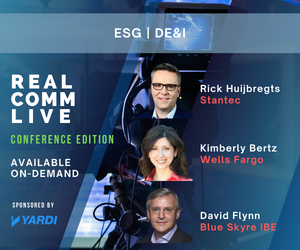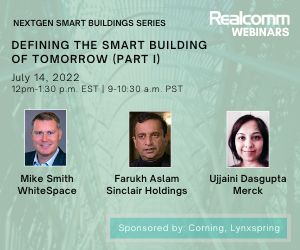Data-Driven Evaluations of Real Estate Needs

It’s already a bit cliche to talk about how COVID has reshaped industries, business models, habits and more, but the fact is that we’re still in the process of discovering just how profound many of those changes are.
This is especially true in the workplace. By now, everyone knows how remote work has changed the way companies are organized, how teams work together, employee expectations and more. But there is another aspect that we’re just beginning to appreciate – how the pandemic has created the opportunity for a reset in the way we think about how we use office spaces.
The spark behind this revaluation was a practical consideration. Looking at so much empty but still costly corporate office space, stakeholders were confronted with the problem of what to do with it when most of their staff was working from home. A question that was rarely posed before suddenly took on urgent importance - “Do we really need this much space?”
Now, moving on from the worst of the pandemic and some staff choosing to return to the office in a newly flexible model, the opportunity to recalibrate real estate commitments to actual needs has become a must. And determining those needs is not as easy as doing a simple headcount of everyone who wants to work from the office. The process of answering “Do we really need this much space?” starts with another question - “How are we using the space we have?”
As with so many other business variables, today’s answer to this question has to be backed up with data. Rough estimates and best guesses are no longer sufficient when precise measurements are possible. And with so much at stake - real estate is typically the second-largest line item expense after payroll - businesses that don’t seize this opportunity to right-size their spending will be left at a competitive disadvantage.
What the data can tell you
Without the right data, you don’t know if a space is fully utilized. However, with a clear picture of how you use your space, you’re in position to make smarter decisions that have a positive impact on your bottom line.
Instead of being a necessary, but benefit-neutral business cost, today’s size-optimized workspaces can be a competitive advantage in several ways:
- Reduced real estate costs. Buy or rent what you really need.
- Improved employee productivity. Employees have access to the kind of space they need when they need it.
- Better employee experience. Workspaces can be a place where employees want to spend time.
- Higher staff retention. The quality of their working environment is something employees consider when looking at other options.
- Decreased energy consumption. Every square foot of space that you don’t need is a square foot of space you don’t have to light, cool or heat.
How you get the data you need
So, making the case for applying data to corporate real estate needs is easy and the benefits are obvious, but how do you get this data that brings so many things into focus? Digital networks powered by Bluetooth® Low Energy (Bluetooth® LE) have opened a world of possibilities thanks to their ability to track and trace movement through spaces. By digitizing mobile assets, you can create virtual maps with traffic patterns based on extensive historical data. These maps reveal far more than simple manual observation ever could and provide hard statistical documentation of how your space is really used.
Gaining new awareness and insights
Digitized spatial analysis illustrates indoor interactions between equipment, people and spaces, making a number of use cases possible, including:
- Spatial awareness. Understand how your space is used, where bottlenecks form, how much of your capacity you’re using and more.
- Environmental awareness. Track and respond to variations outside the norm for temperature, lighting conditions, humidity, and air quality for a safer and more comfortable work environment.
- Location awareness. Track the number and locations of multiple physical assets, employees and more in real time for live insights into occupancy rates and where important devices and machines are.
From tracking room- and even seat-level occupancy in real time to real-time access to exact football traffic in any monitored area and more, Kontakt.io provides the data-driven insights that replace guesswork and estimates with an accurate snapshot of how space is used at any given moment and over time.
- Interfaces that enable employees to enjoy the benefits of buildings that work for people.
- Indoor spaces that assist occupants in their daily mission to accomplish their work goals and provide them with a comfortable, safe and sustainable indoor environment.
- The data that stakeholders need to make informed decisions about how much space they really need and if it’s being used to its full potential.
With the deep insights into occupancy and the office environment made possible by Bluetooth® LE-based networks, you can make informed decisions about space and design matters that maximize the employee experience while optimizing the space needed to achieve it. You can come as close as possible to committing to exactly how much space you need to provide a work environment that boost productivity and serves the needs of your staff.
This Week’s Sponsor
Kontakt.io is the industry leader in indoor environmental, location and occupancy services using Bluetooth Low Energy (BLE ®). Our mission is to deliver human-building interfaces that provide people with delightful, useful, and safe indoor experiences to help make buildings work for people.
Read Next
 5/15/2025
5/15/2025
Tech, Talent and Transformation: 2025 Digie Finalists Announced For 27 years, Realcomm has presented the Digie Awards to acknowledge companies, real estate projects, technologies, and individuals that have advanced the commercial real estate industry through the strategic use of technology, automation, and innovation.
 5/15/2025
5/15/2025
Empowering Space Management with Data-Driven Visualization For effective CRE space management, it’s critical to centralize lease data, maximize rental square footage (RSF), improve energy efficiency and reconfigure spaces to meet changing needs.
 5/8/2025
5/8/2025
The AI-Powered Workplace Evolution: Redefining the Business Landscape In today's rapidly evolving business environment, the fusion of Artificial Intelligence (AI) and Workplace Management is revolutionizing the way organizations approach workspace optimization and operational efficiency.
 3/27/2025
3/27/2025
The Convergence of Edge Computing, Cloud, and AI in Building Automation and Smart Buildings In the built environment, we have seen the convergence of Operational Technology (OT) and Information Technology (IT), later expanding to include Workplace Technologies (WP).





%20(1)%20(1)%20(1).png)







